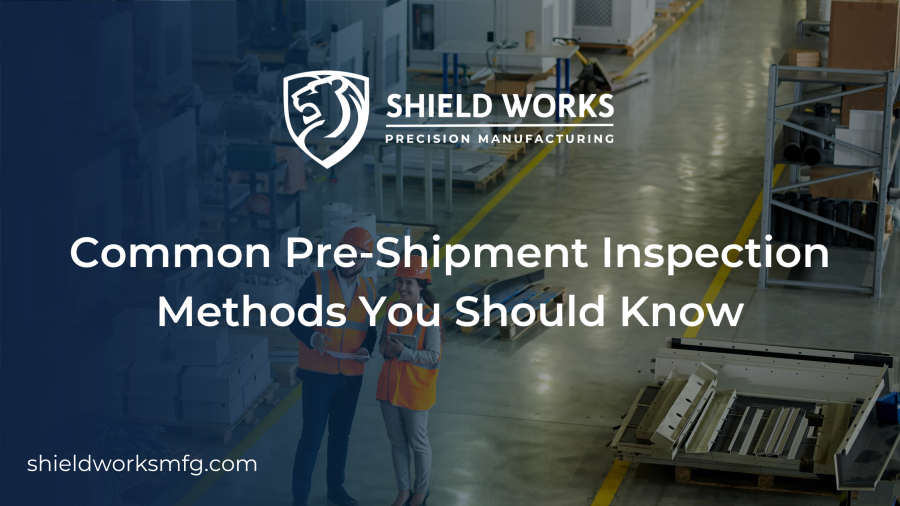Common Pre-Shipment Inspection Methods You Should Know

In the dynamic world of manufacturing, where products traverse global supply chains, ensuring the quality of goods is paramount. Pre-shipment inspections stand as the final safeguard, allowing businesses to identify and rectify potential defects before products reach the end-users.
This comprehensive guide explores the significance of pre-shipment inspections and familiarizes you with common inspection methods to optimize your supply chain management.
Why Pre-Shipment Inspections Matter
In the intricate web of production and distribution, pre-shipment inspections act as the last line of defense against compromised quality. Beyond merely fulfilling a regulatory checkbox, these inspections are crucial for maintaining customer satisfaction and safeguarding brand reputation.
The primary objective of pre-shipment inspections is risk mitigation. By addressing potential defects proactively, businesses can avoid costly recalls, customer dissatisfaction, and reputational damage. In today’s competitive market, where consumers have elevated expectations, delivering flawless products is non-negotiable.
Moreover, pre-shipment inspections serve as a strategic tool for quality control, ensuring that the products align with the specified standards and meet customer expectations. This proactive approach not only saves costs in the long run but also fosters customer loyalty.
Visual Inspection
Visual inspection is the cornerstone of pre-shipment inspections. It involves a meticulous examination of the products to identify any visible defects that may affect the product’s aesthetics, functionality, or overall quality. This method may seem straightforward, but its impact is profound.
During visual inspections, trained inspectors scrutinize each product for surface-level issues such as scratches, dents, or discolorations. This method is particularly effective for goods where the exterior appearance is crucial, like consumer electronics, apparel, or automotive components.
Importance of Trained Inspectors
The effectiveness of visual inspections hinges on the competence of the inspectors. Trained personnel bring an understanding of product specifications and quality standards, enabling them to identify subtle defects that untrained eyes might overlook.
Investing in comprehensive training programs for inspection personnel is a strategic move. These programs should cover not only product knowledge but also inspection techniques, quality standards, and ethical considerations. Well-trained inspectors contribute significantly to the accuracy and reliability of the inspection process.
Random Sampling Techniques
Random sampling is a statistical method employed to assess the overall quality of a production batch without the need for exhaustive inspection of every single unit. Instead of inspecting every product, a representative sample is selected and thoroughly examined. This method strikes a balance between thorough inspection and cost-effectiveness.
AQL (Acceptable Quality Level)
A crucial component of random sampling is the concept of Acceptable Quality Level (AQL). AQL represents the maximum acceptable defect rate agreed upon between the buyer and the manufacturer. Setting an AQL allows businesses to define their quality standards explicitly and communicate them to manufacturers.
Understanding AQL is essential for making informed decisions during the inspection process. It helps businesses find the right equilibrium between ensuring product quality and managing inspection costs. The AQL concept is particularly useful in industries where high-volume production makes 100% inspection impractical.
Functionality Testing
In industries where the performance of products is paramount, functionality testing is a key pre-shipment inspection method. This involves assessing whether the product operates according to its specifications and meets the functional requirements outlined by the client.
Automated Testing Systems
As technology advances, automated testing systems are increasingly becoming a staple in functionality testing. These systems not only enhance accuracy but also expedite the inspection process, making it more efficient. Automated testing is particularly beneficial in industries where products have complex functionalities, such as electronics or machinery.
Investing in state-of-the-art testing equipment is a strategic move for businesses. Automated systems not only increase the speed of the inspection process but also reduce the margin of error. This is particularly crucial when dealing with intricate products where human error may lead to oversight.
Documentation Review
Beyond physical inspections, reviewing documentation is an integral part of the pre-shipment inspection process. This includes verifying that all necessary certificates, labels, and user manuals are present and accurate. The documentation review ensures that the products not only meet quality standards but also comply with regulatory requirements.
Compliance with Regulatory Standards
Ensuring that products comply with local and international regulatory standards is a critical aspect of documentation review. Businesses must stay informed about the latest regulations in their industry to avoid legal repercussions and maintain the integrity of their products in the market.
In the documentation review phase, inspectors check for adherence to labeling requirements, safety certifications, and any other documentation specified by industry regulations. Non-compliance not only poses legal risks but can also result in delays in customs clearance, impacting the overall supply chain.
In conclusion, pre-shipment inspections are the linchpin of maintaining product quality and customer satisfaction in today’s competitive market. By incorporating visual inspections, random sampling techniques, functionality testing, and thorough documentation review, businesses can establish a robust quality control framework.
Investing in these inspection methods is not merely a cost but an investment in the long-term success of any enterprise. It’s a proactive approach that prevents defects, builds trust among customers, and ultimately contributes to a positive brand image in the competitive global market. In the ever-evolving landscape of manufacturing, staying vigilant and quality-focused is the key to sustained success. Partnering with an experienced manufacturer like Shield Works, with their nearly 20 years of QC experience and inspectors based all over Asia will definitely make you rest-assured. Talk to us today!
